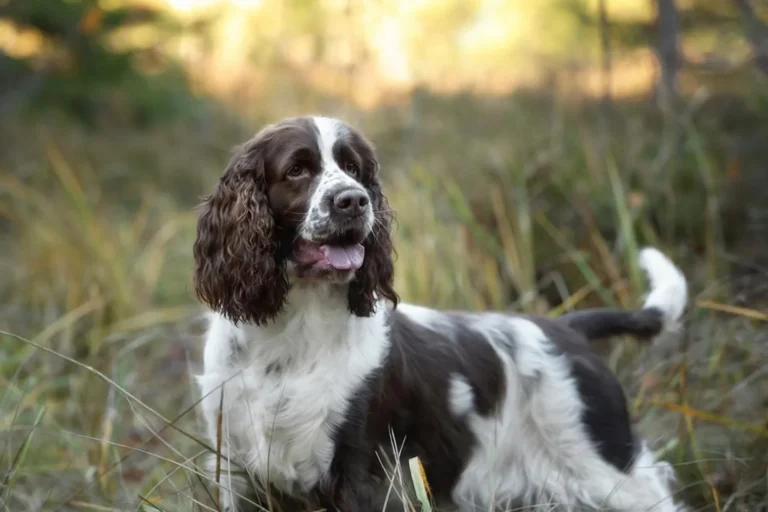
Still very much a working bird dog, the English Setter is one of those rare breeds that can go from sprinting across a field to snuggling on the sofa without missing a beat. I once dog sat an English Setter named Willow who would power through a long morning hike, then spend the afternoon draped across my feet like a living blanket. They’re gentle, affectionate, and wonderfully patient with kids truly versatile companions beyond the hunting field.
If you’re thinking of bringing one home, plan on daily exercise and a bit of “nose work” to keep that clever brain satisfied. A solid recall and a leash or fenced yard are musts when their nose locks onto a scent, their ears sometimes forget you exist. Keep training upbeat and consistent, brush that silky, feathered coat a couple times a week, and give them plenty of company. Do that, and you’ll have a loyal family friend who still lights up at the rustle of a bird in the bushes.
History and Origin of the English Setter
Long before they were couch snugglers and neighborhood charmers, English Setters were hard working hunting dogs in the English countryside. Their roots go back nearly 400 years, likely from crosses of spaniels and pointers that produced a dog with a special trick: instead of charging at birds, they would “set” low to the ground and point them out. I always picture them like a living arrow in the heather, steady and elegant, waiting for a hunter to catch up. I once saw an old sporting print in a tiny pub in Northumberland that showed a setter tucked low in the grass calm as a cat, intense as a statue and thought, yep, that’s their spirit in one image.
The breed we recognize today really took shape in the 19th century thanks to two men with slightly different dreams for the same dog: Edward Laverack, an Englishman, and R. L. Purcell Llewellin, a Welshman. Laverack favored a setter that was not just beautiful and affectionate but also a companion you’d want at your feet by the fire. Llewellin admired those qualities, too, but he leaned hard into field performance drive, stamina, and a nose that could read the wind like a map. A breeder I spoke with in Somerset once told me, “Think of Laverack as the poet and Llewellin as the athlete,” and that comparison has stuck with me.
All that careful cross breeding gave us the modern English Setter: graceful, sweet natured, and born to work. Both styles of setters made their way to America in the late 1800s and quickly found fans. At a field day in Pennsylvania, I met a lightly built, quick footed setter from strong Llewellin lines he floated over the grass like he had springs in his paws. A week later at a dog show in Ohio, a heavier, show style setter with that classic “belton” speckling leaned into my legs like we were old friends. Same breed, two flavors of wonderful.
Even with all that history, English Setters remain relatively rare today, ranking around 98th with the American Kennel Club. If you’re thinking of bringing one home, be prepared to be patient and ask breeders about their lines field versus show can mean different energy levels and training needs. Either way, you’re inheriting centuries of tradition wrapped in silky feathers and a heart that wants nothing more than to work with you, then nap beside you. Honestly, that balance is why I fell for the breed in the first place.

What Is an English Setter?
Setters have been working alongside hunters in England for nearly 400 years, and the English Setter is one of the classics. They likely came from crossing skilled hunting dogs think spaniels for their soft mouths and pointers for their keen noses into a graceful, bird finding specialist. The name “setter” comes from their old school job: when they located game birds, they would “set,” or crouch low and still, to show the hunter where the birds were. I remember watching a friend’s Setter lock into that pose in a meadow once; it was like someone pressed pause on a living statue.
As a breed, the English Setter is medium sized and part of the Setter family, which also includes the fiery Irish Red, the Irish Red and White, and the black and tan Gordon Setter. They’re known for a mostly white coat with silky feathering down the back of the legs and under the belly very elegant and a little reminiscent of a larger, leggier Cocker Spaniel. Many have lovely speckling that makes their coat look hand painted. When an English Setter trots by, tail waving like a feathered fan, it’s hard not to stare.
Today, some English Setters are still brilliant in the field and at dog sports, but they’re equally at home on the couch with their people. They’re typically gentle, sociable, and a bit sensitive real sweethearts who thrive on kind, consistent training. A tip from experience: start recall practice early and keep it fun; their noses can get “borrowed” by every bird in a five mile radius. Plan on daily exercise and sniffy walks to keep them content, and be prepared for nature to hitch a ride in that feathering. After one muddy forest hike, I pulled a whole bouquet of burrs from a Setter’s leg fringe now I keep a slicker brush by the door and a towel ready for soggy bellies. Treat them like the athletic, affectionate companions they are, and you’ll have a graceful partner for both adventure and lazy Sunday naps.

Who Is an English Setter Best For?
If you’re looking for a friendly, gentle companion with lovely manners, the English Setter is one of those dogs that seems to make friends wherever they go. They’re the social butterflies of the dog park happy to greet other dogs, polite with strangers, and wonderfully affectionate at home. I once met an English Setter named Penny at a Saturday market who worked the crowd like a pro tail swishing, soft eyes, leaning in for head scratches from anyone who offered. That easygoing charm is a big part of what makes them such a good fit for so many people.
Families of all shapes and sizes tend to do well with this breed. They’re typically patient with younger children and love being part of the action, whether that’s a game of backyard soccer or quiet reading time on the couch. Thanks to their history mixes that ranged from Spanish Pointer to Cocker they’ve inherited a balanced, people oriented temperament. When my nieces visit, my friend’s Setter will do a slow, gentle approach and then plop down for belly rubs like it’s the most natural thing in the world. They usually get along nicely with other dogs, too, and can live peacefully with cats if introduced properly.
That said, they’re not couch potatoes. English Setters are active, sporting dogs at heart and will thrive with a daily outlet think brisk walks, hikes, or a good off leash run in safe areas. Plan on 60 to 90 minutes of exercise and a bit of brain work, like scent games or hide and seek with treats. Their noses are powerful, and that bird dog instinct can kick in fast; I learned the hard way when one followed a pigeon’s trail across an entire soccer field. Solid recall training and a secure yard are your best friends here.
Training from an early age is important, and it pays off quickly. They can be a little alert and protective at times, but with consistent, positive reinforcement they’ll settle on cue and look to you for guidance. They’re sensitive souls praise and patience go a long way. If you’re home often or have a flexible schedule, even better. English Setters adore their people and don’t like being left alone for long stretches. Mine would curl up at my feet while I worked, content as long as he knew I was nearby.
Grooming is part of the package, too. That beautiful, feathered coat benefits from a good brush a few times a week to keep tangles at bay, especially after romps through grass where burrs love to hitch a ride. Keep an eye on their ears and paws, and you’ll have a dog who not only acts like a gentleman but looks the part, too.
So who is an English Setter best for? Active households, affectionate families, and anyone who wants a sweet, sociable companion that’s eager to join in on daily life. If you want a low energy dog or a serious guard dog, this probably isn’t the match. But if you’re after a loyal friend who gives as much love as they get and you’re happy to return the favor with time, training, and exercise you might just have found your next best buddy.

English Setter Grooming and Shedding
That silky English Setter coat isn’t just beautiful it’s a full-time hobby. Those long fringes on the ears, chest, legs, and tail look stunning when cared for, and yes, they make the best couch cuddle blanket on a chilly evening. I once met a blue belton Setter named Daisy in a New York park whose feathering floated behind her like a little parade sash. Her owner and I swapped tips while our dogs sniffed the same tree for a suspiciously long time.
English Setter colors are a joy to discover. You’ll see orange or lemon belton, liver belton, and even blue belton with tan. “Belton,” if you’re new to the breed, refers to that lovely ticking pattern on a mostly white coat; many pups are born mostly white and the speckles blossom as they grow. A breeder I chatted with in California told me her lemon beltons look like they’ve been dusted with sunshine.
To keep that coat looking and feeling its best, plan on brushing at least three times a week. I like a slicker brush followed by a long toothed metal comb, especially behind the ears, in the armpits, and on the tail those are the tangle traps. During spring and fall shedding, I bump it up to quick daily sessions, which keeps the tumbleweeds down and mats from sneaking in. A little detangling spray before you start can save you both some tugging. Bathing every month or so is perfect for most Setters, and any time they discover something wonderfully stinky to roll in because they will. After baths, I gently blow dry on a cool setting and comb through the feathering to prevent mats as it dries.
Their lovely floppy ears need regular attention. I do a weekly check with a vet approved ear cleaner, especially after swimming or rainy walks, to keep moisture from lingering. Teeth brushing two to three times a week is a good baseline daily if you can swing it and dental chews help on busy days. Nails usually need a trim every few weeks; if you hear that click clack on your hardwood floors, it’s time. I prefer a grinder for smooth edges, and I keep styptic powder nearby just in case.
A few final tips from the trenches: start grooming young so it feels like spa day, not chore day. Keep sessions short and positive, with treats and praise. If you like a very tidy look, a professional groom every 6-8 weeks can neaten the feet, ears, and sanitary areas while keeping the Setter’s natural elegance. And always do a quick post walk check for burrs and brambles those gorgeous fringes are magnets. Your vacuum will still get a workout, sure, but with a steady routine, your Setter will look show ready and feel comfortable, which is the real win.

Do English Setters Bark a Lot?
Short answer: yes, many English Setters are pretty chatty. They’re classic “I have thoughts and I will share them” dogs. Barking is how they say, “Hey, look at that!” or “Pay attention to me, please!” I remember visiting a friend whose Setter, Maple, announced everything from the mail truck to a sneaky leaf skittering across the driveway. It wasn’t angry barking more like running commentary on her day.
Setters were bred as bird dogs, so they’re tuned in to movement and sounds. That alertness can translate into barking at just about anything they encounter: people, dogs, wildlife, new noises, even a squeaky door. Sometimes it’s attention seeking; sometimes it’s excitement; sometimes they’re just bored and looking for a job. For some folks, that level of vocal honesty is a dealbreaker. But if you live on a farm, have a big garden, or your nearest neighbor is far enough away that the squirrels are the only ones filing noise complaints, a Setter’s ongoing narration can be perfectly acceptable even helpful.
If you love the breed but want to keep the volume reasonable, management and training go a long way. First, meet their needs: a tired Setter is a quieter Setter. Plenty of exercise, sniffy walks, and a bit of brain work each day think hide and seek with treats, puzzle feeders, or basic obedience games can take the edge off. I had good luck with a “settle spot,” a comfy mat by my feet where I’d reward calm lounging. Also, reduce triggers when you can: close the curtains during peak delivery hours, use white noise, and give them something to chew when the neighborhood gets busy.
Teaching “quiet” is surprisingly doable. I like to start by naming the bark “speak” so the dog learns that the noise is a behavior, not a reflex. Then I cue “quiet,” wait for even a beat of silence, and pay generously. Timing matters: reward the calm before your Setter ramps up, and don’t yell over the barking (they often hear that as you joining in). My friend’s trick for doorbell madness is gold: as the bell rings, toss a small handful of treats on a mat, then calmly guide the dog to it. Now the bell means “go to your spot and snack,” not “sound the alarm!”
At the end of the day, English Setters will likely have more to say than some breeds. If you’re in a peaceful, space rich setting, their chatter can fit right in. If you’re in a condo with thin walls, you’ll want a solid routine and a sense of humor. Either way, with a bit of training and a lot of patience, you can turn that enthusiastic commentary into something you can live with and honestly, it’s part of their charm.

Average Weight and Height of an English Setter
Most English Setters fall into a pretty consistent size range, which makes guessing their adult build a little easier than with some breeds. Males typically stand about 63 to 70 cm tall at the shoulder (roughly 25 to 27.5 inches), while females are usually around 58 to 63 cm (about 23 to 25 inches). When it comes to weight, males usually come in at 33 to 40 kilos (around 73 to 88 pounds), and females are generally about 45 to 55 pounds (roughly 20 to 25 kilos). In my experience, that “sweet spot” sizing is part of their charm substantial enough to feel sturdy, but still graceful and athletic.
If you’re measuring your Setter at home, do it at the withers, which is the highest point of the shoulders. I prop a book flat on the shoulder and use a measuring tape down to the floor learned that trick after my first attempt with a wiggly pup and a crooked tape measure. For weight checks, the bathroom scale method works: weigh yourself, then weigh yourself holding the dog, and subtract. I once had to bribe mine with a smear of peanut butter on the mirror just to keep him still long enough.
A quick tip for keeping them at a healthy weight: you should be able to feel the ribs with light pressure and see a gentle tuck at the waist. English Setters love to run and play, so regular exercise does a lot of the work for you. As pups, they can have dramatic growth spurts one week their legs look a mile long so don’t panic if they shoot up before they fill out. Keep meals balanced, watch the treats, and let their elegant, athletic shape shine through.
https://en.wikipedia.org/wiki/English_Setter

Are English Setters Easy to Train?
English Setters are smart, gentle, and eager to please, which makes training very doable if you keep it upbeat and consistent. The bird dog brain is real, though. They’re quick to pick up cues, but just as quick to tune you out if a fluttering leaf or a whiff of something feathery catches their attention. Short, positive sessions work best. I like to end on a win, with a treat and a cheerful “That’ll do!” so they’re excited to try again next time.
These dogs need plenty of exercise from puppyhood right through adulthood. Think daily walks with time to sniff, plus play sessions or a jog as they mature. I plan Setter days like a little routine: a brisk morning outing, a midday mental game (snuffle mat or hide and seek with kibble), and training or fetch in the evening. If you work from home, weave in mini training breaks. If you’re out for a few hours, exercise before you leave and offer a safe chew or puzzle toy to keep their brain busy.
A fenced yard is a big help, not just for play but for safety. Setters have a wandering streak when their nose kicks in. I learned this the day mine locked onto a butterfly and trotted toward the horizon like he had an appointment. A secure fence and a long line for recall practice saved us both a lot of sprinting.
Start obedience classes young to build good manners and confidence. Setters are sensitive souls, so use gentle corrections and lots of praise. Early socialization, a rock-solid recall (a whistle helped us), and consistent routines add up. With the right mix of exercise, structure, and encouragement, an English Setter becomes a joy to train and a wonderfully polite companion at home and out in the world.

How Do English Setters Behave? A Look at Their Temperament and Personality
If you’re after a kind, gentle, and affectionate companion with a cheerful spark, the English Setter is your kind of dog. They’re wonderfully people focused, often happiest with their head on your knee and their tail swishing like a feathery metronome. Give them a chance to stretch their legs and they’re all “let’s go!” a lively, get up and go partner for walks, hikes, or backyard games. Then, once the energy is out, they melt into calm, cuddly housemates. I once looked after a neighbor’s Setter who would sprint joyful loops at the park, then come home and carefully curl up on my feet like a polite guest.
Their naturally sweet personality really shines when you pair it with thoughtful socialization and gentle training. Setters are soft hearted; a harsh tone can deflate them, but upbeat praise and treats make them glow. Early on, introduce them to friendly dogs, different people, new sounds, and odd surfaces think umbrellas, traffic noise, even the vet’s scale. Because that bird dog nose can lead them astray, start recall practice young. I like a long line in a quiet field, chicken bits in my pocket, and a happy voice. A few minutes of nose games or simple obedience between walks keeps their busy brain content, especially on rainy days.
English Setter puppies show their personality early you’ll see those affectionate lean ins and the adorable “pause and point” when a sparrow flutters by. Give them plenty of attention and short, fun training sessions, and expect a playful, slightly goofy streak that lasts well into adulthood. Consistency, routine, and positive reinforcement help them blossom into the loving, merry companions they’re meant to be. And yes, you’ll probably fall head over heels most of us do.

Does the English Setter have any common health issues?
English Setters are generally sturdy, happy go lucky dogs, but like most breeds, they do have a couple of issues that pop up more often than we’d like. Over the years, I’ve learned that a bit of awareness (and a good relationship with your vet) goes a long way in keeping these graceful bird dogs comfortable and thriving.
Elbow dysplasia is one to watch for. It’s a heritable condition tied to the way the three bones in the elbow grow and fit together; when they don’t line up properly, it can lead to joint laxity, lameness, and arthritis. In day to day life, that might look like stiffness after a nap, a subtle limp after a hard play session, or a reluctance to jump into the car. One of my setters started “bunny hopping” after a long romp, and that little clue sent us to the vet early. With weight management, joint friendly exercise like swimming, and a few anti inflammatory days when needed, he stayed comfortable. If you’re bringing home a puppy, ask the breeder about elbow clearances from certified organizations good breeding decisions make a real difference.
Hypothyroidism is another condition to keep on your radar. It happens when the thyroid gland doesn’t produce enough hormone, and signs can be surprisingly everyday: weight gain without extra food, low energy, a dull coat, even fertility issues. A friend’s English Setter, Maple, went from couch potato to her old waggy self within weeks of starting a simple daily thyroid medication after a routine blood test confirmed the diagnosis. Testing is straightforward, treatment is typically lifelong but affordable, and follow-up labs help keep the dosage just right.
My best advice: keep an eye on small changes, stick to a healthy weight, and choose low impact exercise on growing joints. If something feels “off,” trust your gut and book that checkup. These dogs give us everything they’ve got; a little proactive care helps them enjoy every adventure right alongside us.

What Is the Lifespan of an English Setter?
English Setters are such sunny, good natured dogs that you can almost forget time is ticking by when you’re with them. With good care, most English Setters live about 10-12 years. That’s the average, and I’ve known a few who happily padded into their teens. How long they thrive really does come down to everyday habits: steady exercise, a sensible diet, and regular vet care.
Think of it like this: an English Setter is an athlete at heart. They do best with daily activity long walks, a chance to stretch those legs in a safe area, and some brain work too. I like mixing in scent games or a few minutes of basic training to keep their minds sharp. Keep them lean rather than “well fed”; extra weight can be tough on their joints. Regular checkups, clean teeth, and a quick ear check after playtime (those feathered ears can trap moisture) go a long way. I also keep a comfy bed in a quiet spot good sleep is part of good health.
I remember my friend’s setter, Molly, who made it to 14. Nothing fancy just consistent routines: gentle hikes, measured portions, and a vet who kept an eye on her joints as she aged. When my own setter hit about eight, I swapped out some high impact games for low key sniff walks and added a few short swims in summer. She still got her “zoomies,” just on her terms. Little adjustments like that kept her happy and moving without overdoing it.
Genetics play a role, of course, so choosing a reputable breeder who health tests, or working with a rescue that shares what they know about the dog’s background, can set you up well. But day to day, it’s your steady care that adds up: fresh water, real downtime, mental enrichment, and lots of love. Do those things, and you give your English Setter the best shot at a long, healthy life in that 10-12 year range and maybe a little beyond.
How much should an English Setter be fed?
For most adult English Setters, a good starting point is 2 to 3 cups of quality dog food per day, split into two meals. Breakfast and dinner keep their energy steady and help maintain a healthy weight. On days when my Setter and I clock a long hike or a big training session, I’ll bump dinner up a touch; on lazy, rainy days, I stick closer to 2 cups. The key is consistency with a measuring cup those heaping scoops add up faster than you think.
Treats count, too. I learned that the hard way when we were doing lots of recall practice and my dog quietly packed on a couple of pounds. Now, if I know we’re using more treats, I shave a quarter cup off the kibble that day. I also check his body condition weekly: I should be able to feel ribs under a light layer of padding and see a tidy waist from above. If he’s getting a little soft, I’ll dial back by a quarter cup and recheck in a week. Slow feeder bowls are great if your Setter inhales meals, and fresh water should always be available.
A few extra tips I swear by: avoid hard exercise right before and after meals English Setters are deep chested, and spacing meals from vigorous activity can help reduce bloat risk. If your dog is picky, a splash of warm water or a spoonful of plain pumpkin can make dinner more appealing without overdoing calories. Puppies typically need smaller, more frequent meals, while seniors may do better with a bit fewer calories your vet can help fine tune. And if you ever switch foods, transition gradually over 7-10 days to keep tummies happy. My friend once tried free feeding her Setter, and he ballooned; moving to two measured meals brought him right back to his lean, bird dog best.
English Setter FAQs
I get these questions all the time from friends who fall in love with an English Setter’s sweet face and silky ears. Here’s what I’ve learned from living with and loving this gentle, bird obsessed breed.
At what age do English Setters go into heat?
Most English Setter females will have their first heat right around the six month mark. That said, it can show up a bit earlier or later depending on the individual, so don’t be surprised if your girl doesn’t follow the calendar perfectly. I remember my friend’s setter, Daisy, cruising past six months with nothing and then suddenly, at seven months, there it was. Watch for signs like slight swelling, spotting, a change in friendliness with other dogs, and more interest from male dogs. My advice: keep a simple calendar, talk to your vet about timing for spaying if that’s your plan, and use a well fitted doggie diaper during the heavier days. During walks, keep her on leash and steer clear of off leash parks until the cycle passes.
Are English Setters ideal for first time dog owners?
Absolutely. Their friendly nature and zest for life make them a great fit for all kinds of households, including first time owners. They’re sociable, gentle, and usually eager to please, which makes training feel more like a fun conversation than a chore. Just remember they do best with daily outdoor play and a chance to stretch those long legs. If you’re new to dogs, think: a couple of good walks, a reel of fetch or a sniffy game in the yard, and five to ten minutes of short, upbeat training. A neighbor’s first dog was an English Setter, and she was surprised by how quickly he picked up the basics once she kept sessions light and consistent.
At what age do English Setters calm down?
Most settle into a more relaxed rhythm as they reach adulthood usually somewhere between one and two years old. Even as puppies and adolescents, they’re more placid than people expect; they’re not typically the nonstop, bouncy type. Mine had classic “zoomies” after dinner, then turned into a nap loving shadow under my desk. If yours feels a bit extra during the teenage phase, don’t worry; stick to a routine, give them a job (simple scent games or easy obedience), and you’ll see that easygoing temperament shine through as they mature.
Are English Setters good swimmers?
While they aren’t historically known as water dogs, many English Setters enjoy swimming, especially when it plays into their bird hunting instincts. I eased my setter into shallow water with a floating bumper; by the third visit, he was paddling out like a pro. Go slow, choose calm water, and consider a canine life jacket the first few times. Always give them a clear way in and out, keep sessions short, and rinse that beautiful coat after a dip. If they’re not sure at first, that’s okay gentle encouragement and a fun “find the toy” game can turn curiosity into confidence.
Disclaimer:
This article is for informational purposes only and doesn’t replace professional veterinary or training advice. Always consult a certified vet or dog trainer for guidance specific to your pup.





